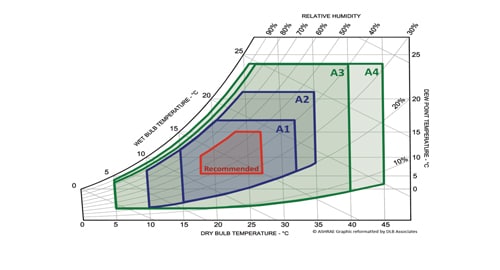The ASHRAE Technical Committee TC9.9 had its beginning from a group of thermal engineers from the various IT manufacturing companies (15 companies in all made up of members who were acquainted through ASME conferences). Those first meetings starting in 1999 focused on 4 topics that our Thermal Management Consortium considered lacking in the industry:
ü Power Trends of IT Equipment
ü Common Rack Air Flow Directions
ü Common Environmental Guidelines for IT Equipment
ü Common Documentation of the Environmental Conditions for Servers
Because of the rapid increase in CMOS servers in the 90’s, it was incumbent on the team to first publish the power trends of IT Equipment, which we did through the Uptime Institute in 1999 (at that time our team was not a member of any organization so Uptime agreed to collaborate with our Consortium to publish this first IT equipment power trend chart). Then in 2002 the Consortium Team moved to ASHRAE to start the technical committee TC9.9 in order to achieve a wider audience through the ASHRAE organization. Since the Consortium had already started work on the other 3 items as outlined above, it was clear that these would be the first items to focus on in the new ASHRAE committee.
ASHRAE Technical Committee 9.9 brings the disparate interests in the datacenter industry together in the area of datacenter cooling technologies. The groundbreaking publication ‘Thermal Guidelines for Data Processing Environments’ (ASHRAE 2004) helped create a framework for enabling all in the industry to speak a common language and better understand the implications of ITE cooling requirements on the datacenter and vice versa. Since ASHRAE’s ‘Thermal Guidelines for Data Processing Environments’ was first created in 2004 and updated in 2008, improving datacenter efficiency has become an even higher priority for datacenter operators. The 2004, 2008, and 2011 Guidelines were primarily written by representatives from the IT equipment manufacturers (many of the same ones that were members of the Thermal Management Consortium).
This IT Subcommittee (the original Consortium was eventually formed into a separate ASHRAE subcommittee within TC99) contains the expertise for understanding the limits of the components that make up computing equipment while ensuring adequate reliability and performance within cost constraints. The ITE manufacturers carefully consider their customers’ requests and create products to support their customers’ needs. Wider environmental guidelines support is now transitioning from a niche requirement to the mainstream necessitating standardization to ensure compatibility in datacenters that house a variety of equipment from various manufacturers. The 2004 version had recommended limits of temperature up to 25oC while the 2008 version expanded the upper limit to 27oC. These earlier versions had two data center classes that had maximum allowable temperature limits of 32 and 35oC. To enable improved operational efficiency of the data center the ASHRAE Technical Committee 9.9 updated the Thermal Guidelines in 2011 by adding expanded environmental classes that allow temperatures up to 40 and 45oC and providing detailed guidance to data center operators on the best environmental range for each data center. These new environmental temperature and humidity limits along with the recommended limits are shown in the psychometric chart below(Although temperature limits were discussed above, moisture limits are equally as important and both can be displayed in the psychometric chart). Most IT equipment manufactured today fall within the A1 and A2 classes, while future equipment will most certainly fall within classes A3 or A4 to aid the industry in increasing energy savings.

The ASHRAE TC9.9 data center whitepapers and Datacom books can be accessed on http://tc99.ashraetcs.org/. The committee is now focused on a number of areas, such as effect of relative humidity on equipment failure, networking and storage requirements for data center operation, application of economizers to data centers and other important areas critical to the industry.
Dr. Roger R. Schmidt, IBM Fellow, National Academy of Engineering Member, IBM Academy of Technology Member and ASME Fellow, has over 35 years experience in engineering and engineering management in the thermal design of IBM’s large scale computers. He is IBM’s Chief Engineer on Data Center Energy Efficiency. He has led development teams in cooling mainframes, client/servers, parallel processors and test equipment utilizing such cooling mediums as air, water, and refrigerants. He now leads IBM’s Advanced Thermal Energy Efficiency Lab which develops advanced electronic cooling technologies and provides customer support for power and cooling issues in data centers. He has published more than 100 technical papers and has over 125 patents/patent pending in the area of electronic cooling. He is past Chair of the ASHRAE TC9.9 committee.




